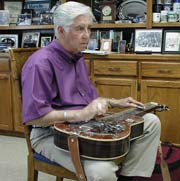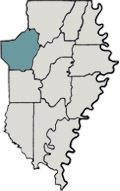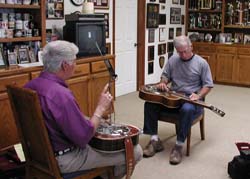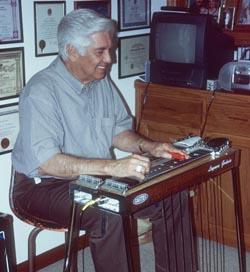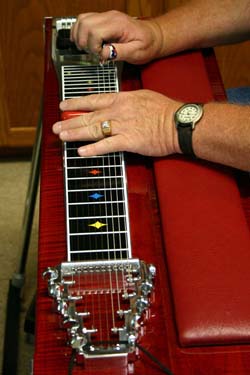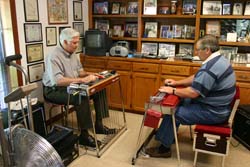Introduction to Delta Pieces: Northeast Louisiana Folklife
Map: Cultural Micro-Regions of the Delta, Northeast Louisiana

The Louisiana Delta: Land of Rivers








Ethnic Groups










Working in the Delta








Homemaking in the Delta




Worshiping in the Delta



Making Music in the Delta






Playing in the Delta







Telling Stories in the Delta



Delta Archival Materials
Bibliography

Laymon Godwin: Pedal Steel and Dobro Master
By Susan Roach
While the Delta has been known for blues and rockabilly, country music permeates the whole region, providing a main ingredient of rockabilly. Old time country music brought into the state by settlers of Anglo-Scots-Irish descent continued with local house parties, country music shows, and jams and was reinforced by commercial AM radio from Nashville and as far away as Hawaii. These local and global sources of music inspired Laymon Godwin, from West Monroe, on the western edge of the Delta region. Talented enough to play music fulltime, Godwin instead chose a career in law enforcement, while playing pedal steel and Dobro (resophonic slide guitar) in country and bluegrass bands across North Louisiana.
Laymon Godwin was born in 1932 in the small community of Indian Village, about four miles southwest of Calhoun in Ouachita Parish. His parents, Burley and Mattie Godwin, sharecropped on 39 acres but were not successful, so they quit. Then, his father had a brief stint as a Pentecostal preacher and moved the family to Monroe. Music played a typical role in Godwin's family. Godwin's father served as a choir director in church although he did not read music. In Godwin's youth in the 1940s, his family often spent Saturday nights listening to radio broadcasts of the Grand Ole Opry in Nashville on WSM. The AM radio also provided another even more important musical experience for Godwin when he was about eleven:
The first music that I really heard that I really loved was Hawaiian. And I lay awake at night, and on the weekends you could get Webley Edwards [radio announcer] on the Royal Hawaiian Hotel on Waikiki Beach on Saturday nights, and it would be some of the most beautiful Hawaiian music, and I will never forget that he would talk about, "They are playing music under the banyan tree on Waikiki Beach; the water temperature is 75 degrees, and a cool breeze coming across the ocean." I just fell in love with that kind of music. (22 December 2013; see Hawaii Calls")
Through these experiences, the young Laymon first became attracted to the steel guitar, which would lead to a long music career that would accompany and outlast his regular job in law enforcement.
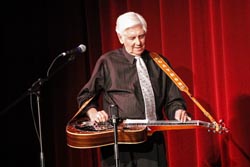
After graduating from Neville High School, Godwin joined the army in 1953. Having served as a paratrooper the Eleventh Airborne Division, he was discharged and came home in the mid-fifties. While he was attending college on the GI Bill at Northeastern State University (now University of Louisiana at Monroe), he had two part-time jobs—playing music in a dance band in night clubs and working weekends at the paper mill.
When he became engaged to be married, he began seeking a steady job. While he had served as a prison guard in the army, he had not considered a career in law enforcement. He says, he "backed into it" through a newspaper advertisement for Monroe police officers. He obtained a position in the Monroe police department, where he worked for the next three years, earning $290 per month for six days a week with one holiday a year. He relates his first duties on the job as a policeman and his minimal training:
I started out walking the beat, if you know what that is, shaking doors on Desiard Street, when Desiard Street was the main street in town. . . . I started out there, little to no training; they just hired me and told me to go buy a gun, which I did, and I started walking the beat, and within two or three weeks they were going to start a class, and it was a two-week class given by the police officers there at the Monroe police department, and that was my formal training—two weeks of how to enforce the law. And when I got out of there, I still didn't know how to enforce the law. The theory was if it has to be you or him, it'd be better for you to be in front of the jury explaining why you killed him than him in front of the jury explaining why he killed you. That was the theory we operated on. (10 June 2003)
With this low pay and few benefits, he quit his police job and went to work for Southern Air Ways for about six months until the company went on strike. He was asked to return to the police department, but he saw no future there, so he applied at the Ouachita Sheriff's Department and at Brown Paper Mill and received offers from both. He explains his choice: "So I was real blessed, but I took the Sheriff's Department, because I missed the law enforcement. After a couple of years in it, it just really sort of grew on me, and I missed it dearly. So I went, went back, and over the years it was real good to me. I was deputy sheriff for many years" (10 June 2003).
He worked with the Ouachita Parish Sheriff's office for the next 20 years until he was elected Ouachita Parish Sheriff, a position he held until his retirement in 1996. Throughout his career as sheriff and afterwards, he has continued to play steel guitar and later Dobro with a variety of bands, as a paid musician and as a community volunteer. When he plays pedal steel with a band and is introduced as the sheriff or today as former sheriff of Ouachita parish, he typically responds with a slide on his pedal steel imitating a police siren. Highly respected and well known throughout the region for his work in law enforcement, Godwin has earned equal respect for his musical talent on pedal steel and resophonic slide guitar, both of which are among the most difficult instruments to master.
Learning the Steel Guitar and Dobro
As a result of Godwin's attraction to the steel guitar in his boyhood, his parents bought him his first instrument as a gift:
I got one [steel six-string] from a birthday—I think really about my eleventh or twelfth birthday, but prior to my getting my own little steel six-string you sit on your lap and play, they call them Hawaiian guitars back in those day. We had something like this [raises guitar], like a strumming guitar, and they turned it over. It didn't have this resonator on it. . . . They were acoustical, no amplification or anything. And I used to go on the porch and just play it like this [in his lap with a bar]. This same tune, the first song I ever learned. I took seven lessons from a guy named Luke Morris. I think they were twenty-five cents a lesson at Hewitt Music Company back in the forties and this is the way he taught me. Let me see if I can play the first song I ever learned. . . . I did it like this: [plays the tune]. (21 May 2003; see video below.)
He describes the six-string lap steel: "That was the original Hawaiian guitar. Back in the 1940s, Alvino Rey had an orchestra and played a steel guitar that had pedals attached to cables that activated the strings. It wasn't the country sounds that we have today. Then about 1950, someone added pedals with rods. They named it a pedal steel guitar" (15 June 2005). After his lessons from the music store, he continued to learn by listening to other steel players he met, as well as radio and records. By the time he was in high school, he was playing in country bands around Monroe. His steel guitar music gigs helped him pay his way through college, where he earned a general studies degree.
According to Godwin, most pedal steel guitars today are custom built, as is his; the pedal and lever pulls are set for the particular player. The pedals and levers function to raise and lower the strings to make different chords. A musician can change chords without ever moving the bar on the strings. For his current instrument, he has had five knee levers added to the guitar to expand the possible pulls on each string. He describes how he had one built to fit his own leg length:
You can buy little student models, but they all come the same size, and if you happen to be a tall, long-legged fellow, you couldn't get under one. I went to Dallas a couple of years ago—and this is probably my tenth or twelfth steel guitar over the 40, 50, 60 years I've been playing—but I finally got one built to me. I sat down—I have long legs from the knees to the floor, so I had this guitar built to my height, and you have to allow for your pedals; you raise your foot up two or three inches on that [pedal], so your guitar has to be high enough so your knees will clear. Also, they have these knee levers under here [two on one knee; three on the other]. . . . So they have to place those knee levers where you can wiggle your knees. (15 June 2005)
Custom built steel guitars have many options, as Godwin illustrates by comparing his own pedal steel with that of his apprentice:
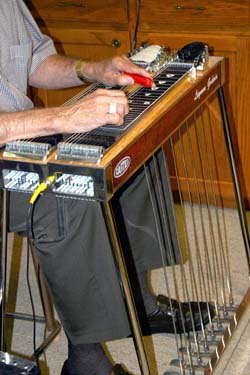
His [apprentice's] is made out of wood. Mine is made out of Formica. He's got a George L pickup; I have a different kind of pickup on mine. He's got ten strings on his. I've got twenty strings on mine. He's got three foot pedals on his; I've got eight foot pedals on mine. They come in any color you want from black to bright purple and yellow. They can make them anywhere from six to fourteen strings and put as many foot pedals as you can get on the floor; about ten is normally about all you get. And some of them have as many as seven or eight knee levers under the bottom to help you get different sounds. Everybody uses different kind of amps. He uses a Peavey amp, and I use an Evans amp. He's got a different kind of volume control. So they're all guitars, but they're all different: different heights, different materials, different tunings on them, and that's the reason, as I was telling you, I can hear somebody playing, and if I've ever heard them play before, [I] can tell who it is. You don't even have to see their face; you'll know who's playing by the touch of the guitar how they play it and the tunings they use. So it's a fascinating instrument. It's really only been around for about 55 or so years. . . . Since about '50, or '55, they've become somewhat standardized in that they all look similar to these, and the pedal setups are very similar, but everybody comes up with something different that they want. (15 June 2005)
Because of these vast differences, there are no standard books on how to play these custom instruments, which means there are few musicians who can play these complicated custom instruments. As Godwin explains, the pedal steel is a complex instrument which requires using hands, feet, and knees to play:
I know when you are playing, you're wiggling the strings with your finger; you're sliding the bar with this hand, you're wiggling your knees with your knee pedals, you're pushing the volume with this foot and you're pushing this pedal with this foot. So you've got both hands all your fingers, your legs and your feet all working and picking these strings; that's what makes it really a difficult instrument. You've got to be well coordinated to do all of that. (15 June 2005)
While Godwin has played the pedal steel guitar for over 60 years, he has been playing the resophonic slide guitar (typically called a Dobro) for about 13 years. Godwin explains the name of the instrument:
A Dobro is actually a misnomer. A Dobro is a brand name, like a Ford or Chevrolet. A Dobro is a brand of guitar, and my guitar happens to be a Jasper resophonic guitar. . . . The name Dobro really originated 75 years ago. But the guitar is really a square neck resophonic slide guitar. . . . It's an acoustical guitar for strumming. This was a resophonic square neck, slide guitar for Hawaiian style Dobro picking, but most people know it, just like a piano, you would say, "I play a Wurlitzer." (21 May 2004).
He describes what led him to the instrument and how he got his custom-built Dobro with his own initials on it:
About five years ago, we were playing for a lot of church senior groups. And we were playing the same old thing over and over, and I wanted to do something a little different, add a little variety to it and entertain them. And most of the folks had heard this sound, listening to the Grand Ole Opry, but didn't know what was making that sound. If you would say "Dobro," it would be. . . , "What's a Dobro?" Most people don't know what a Dobro is. This [his instrument] is a Jasper brand Dobro. Floyd Jasper, a guy in Greenwood, custom built this for me. (10 June 2003)
He notes that while his motivation for purchasing a Dobro originated in his group's performances of gospel music for senior groups, he soon discovered the role of the instrument in bluegrass music, and finally learned how to play it:
And when I bought one of these [Dobros], we played the steel guitar at churches and things, and I thought we'd add a little something extra, a little different sound. And the first song I learned was [plays "Great Speckled Bird" excerpt], and that was an old Bashful Brother Oswald [Beecher Ray Kirby] song. He used to do that old mournful thing at the Grand Ole Opry all the time, and people loved it. Well, we do a lot of church work for senior groups, playing for the "Keenagers" they call themselves, old folks, and so I bought one of these things [Dobro], thinking it might entertain them, and I was doing that kind of stuff at first. And then all of a sudden, I heard this: [demonstrates fast-paced bluegrass], real fast banjo picking [more bluegrass], that kind of stuff. I said, "Man, I got to learn that." And then I got to where I couldn't [learn anything further]. There was no one to show me this stuff around here. And not many Dobro pickers around here and I couldn't really find anybody who could really show me, so basically the one I had, I put in the closet for a year or two. And I didn't play it anymore because I just got—I couldn't—I wasn't learning—no one to show me anything. And finally I got with a guy here in town that began to show me stuff, and then I began to find out you could buy videotape teaching tapes. And with those tapes and Marty Kutz—he showed me some things that really helped get me going. And then I got my interest renewed. (29 May 2003; see video below.)
Godwin explains that Dobro musicians in north Louisiana are scarce:
There's only three people in north Louisiana that I'm aware of that can play one decently, good enough to play with a band. Several people have them and play around with them, and I'm number three. There's a guy that built mine [who] is great, and there's a guy in Monroe that's a preacher, but he played with Josh Graves [from Monroe County, Tennessee]. He's the guy that made this thing [Dobro] famous back in the '50s. He played with [Lester] Flatt and [Earl] Scruggs.
While he learned to play the resophonic guitar later in life, part of his success in learning it had to be based on his early history with the steel six-string guitar, which helped him in learning to pick the Dobro, but hindered him as far as using the bar on the strings:
I had an advantage since I already played the steel guitar, so this part [gesturing fingers with picks] worked for me [gestures with his hands and picks] but this part didn't work too well [gestures to the bar in his hand] because the steel guitar bar [uses] a big round bar; this bar is flat on the ends, and it's got a ridge on it. The steel guitar bar is just a round-nosed piece of metal. [But] this bar has to be flat because you have to do those hammer-ons and pull-offs [demonstrates] And on the steel, you couldn't do that with a steel guitar bar. (29 May 2003)
Over the years he has amassed over a hundred recordings of traditional steel guitar and Dobro music dating back to the 1940s. His collection of recordings of pedal steel musicians who influenced him include Jerry Byrd, Buddy Emmons, Lloyd Green, Jeff Newman, and many others. He has also attended steel guitar conventions to learn more about the instrument. Thus he has learned to play both instruments "by ear," both in the folk tradition and by listening to recordings. He does not read music, except for the Nashville number system. He did play drums in high school band, but that did not require reading music.
Styles of Playing
Godwin's Dobro style is influenced by "old-time mountain music, early country music with its Hawaiian influence on Dobro guitar playing styles, gospel, and bluegrass music" (22 Feb. 2002). He has developed his own style; many think that his style is unique. On the Dobro, he uses a "finger pull" that he developed. Godwin describes the styles of Dobro playing:
This instrument's so different. It's played two styles. The style I was just playing is the Hawaiian style, and that's the slow stuff, the "trilling," I call it. . . . Real pretty type of stuff, but corny. And then there's a new style that's come out lately, and this instrument basically put in the bluegrass music; it's called a banjo style where you pick it really fast. And that's the part that's hard to get. (10 June 2003)
In playing the pedal steel, Godwin believes that each steel player has his own style:
There's no particular style of playing. I can hear probably twenty steel players in the country play, some of the better knowns that I've heard several times, and . . . as soon as they start playing, I can tell you who it is. They all play guitar, but they all sound different, just like your voice. It's different basically from everybody else's. Somebody could, if they know you, they can hear you say two or three words; they know who it is. [It's the] same way with a touch on a steel guitar. You develop a certain touch. (15 June 2005)
Once he became totally comfortable with each instrument, he says he did not have to concentrate on playing particular notes and licks: "Well after a while it just comes natural, you know. I don't remember a whole lot of anything, but what I'm playing, I just play it by feel" (15 June 2005). He explains further that he has had to learn basic "licks" and internalize them so that in his mind so that muscle memory takes over in a performance:
You can't think ahead of time when you're going so fast. You just have to know those things because you don't have time to think: "Well I'm going to do this lick next, I'm do that lick in about four beats, I'm going to do it different." You don't have time to do that. Nobody's mind works that fast, so you just got to sort of have that in your repertoire, in your head when you're playing you're going more by sounds than you are [notes]. You don't know what notes you're playing, what key you are in, or anything; because sometimes you're playing different strings and you might be in "F" position playing the "G" string, something like that, so it's confusing. So you just got to get that in your head and make part of your repertoire and you should practice it. And you know it's there. . . . It's a short way of moving the bar [and] saves you a little time when you're going fast and also it helps you to learn your neck too. (15 June 2005)
Godwin has found that he plays differently depending on his mood and frame of mind: "Amazingly, your mood has a lot with what you play; how well you feel and everything. On some days I can just tear this thing up. Come back the next day and all fumbling around. . . . But if I feel real good, I can do some beautiful things" (15 June 2005).
Ultimately, Godwin plays a more traditional pedal steel and Dobro style than professional steel musicians might play. Godwin himself truly enjoys the more esoteric music produced by professional steel players who perform at steel conventions: "A steel player loves another steel player that's fantastic and can do all kind of stuff. And some of the guys are so good they are way off in left field and they can do crazy things that nobody else knows" (22 December 2013). However, as Godwin sees it, "The general public doesn't like that crazy stuff. . . . But when it comes down to easy listening, you want somebody that just plays straight melody, pretty music and all that without all that cutting up a lot. . . . Now on the Dobro, I can cut up a little bit, but on the steel I try to keep it straight and "commercial" as they call it" (22 December 2013). He reports that professional musicians have termed his style, "commercial," which is an interesting term for a style that one would consider to be traditional: "That means the nuts and bolts, the downhome type stuff" (22 December 2013). His traditional style has attracted many fans over the years, according to Godwin: "A lot of people who follow me and have been following me for years, they just love what I do; they don't understand that there are people who are just way better than I am" (22 December 2013).
Performances
Godwin estimates that he usually plays somewhere two to three times per week. Given the nature of the steel and Dobro, Godwin does not typically perform solo, but plays with many different bands, ranging from country to bluegrass. When he's not out playing, he still likes to play solo at home during the week. His venues include festival, dances, jams, restaurants, nursing homes, and country and bluegrass shows. Because there are few Dobro musicians in the area, he is often in demand to play with bluegrass groups. He has continued to serve as a staff musician with several regional country music shows for over 30 years. For example, he played pedal steel as a staff musician with the Ouachita Valley Jamboree, the Twin City Jamboree, Verlie Carr's Ward 5 Jamboree in Columbia, Wildwood Express country music show and later the Dixie Jamboree in Ruston at the Dixie Theater. He continues to join members of Wildwood Express band when they reprise their earlier show annually as a benefit at the Dixie Theater. He has played for over 50 years with Rich Bailey, Ouachita Parish tax assessor in a country band they named People's Choice, since they were "reluctant" elected officials from the region. It also included Jewett Farley, Lincoln Parish tax assessor, who no longer plays in the group; other band members now include Carolyn Baumgartner from West Monroe on piano and vocals, Ed Sawyer, on lead guitar and Larry Allen, from Marion, on bass.
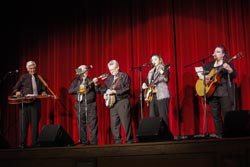
As of 2013, Godwin plays most frequently with Grassfire, a bluegrass band, which on its web blog describes its music as "acoustic instrumentation, all styles of music: bluegrass, bluegrass-gospel, blues-grass/country/rock." While he plays Dobro with this band, he is joined by Angel McLemore, from Winnsboro, on vocals and bass, Dean Keltner, from Winnsboro, on vocals and guitar, Marlon Cobb, from West Monroe, on vocals and mandolin, and Louis Champagne, from Columbia, on vocals and banjo. Although he does not typically sing in the group, he is featured on various numbers and also provides some humorous repartee. In a performance at the historic Dixie Theater in Ruston, on November 16, 2013, Grassfire's 90-minute performance ranged from "Wayfaring Stranger," to "All Shook Up," Godwin played Dobro on every number, showing his versatility and ability to accommodate many musical styles on an instrument rarely used outside of bluegrass music. Godwin also plays dance music with another band, Blue Rhythm, which includes Angel McLemore on drums and vocals, Dean Keltner on piano and vocals, Buddy Maroney on lead guitar, and Danny Allen on bass. Their venues include American Legion Hall and senior dances.
Regardless of the venue or the band, Godwin is the consummate professional, immaculately dressed and groomed, looking distinguished with his full gray hair. He is equally comfortable on both instruments and in bluegrass, country, or rock and roll.
Apprenticeships and Retirement
Since his retirement as sheriff, Godwin plays even more and has been eager to teach others to play both pedal steel and Dobro. While he enjoys teaching novices to play both instruments, Godwin points out that a potential steel guitar musician must have some basic physical skills and timing to play: "Like dancing: there are some people that are left footed and they just don't have a sense of rhythm, they can't hear the timing, and they will just never be a good dancer. [It's] the same way with a musician." Godwin says that he can quickly tell if people have musical talent by having them snap their fingers or clap in time with him and by seeing if they can sing "Mary Had a Little Lamb" on key. (15 June 2005). He was the master artist for two Louisiana Division of the Arts apprenticeships. Jim Lowther, from Ruston, apprenticed with him on Dobro in 2002-03, and Richard Allen apprenticed with him on pedal steel in 2004-05. His attention to and mastery of details such as correct notation, technique, and timing is balanced by his patience and good humor as he guides his students through their lessons.
During a Dobro apprenticeship lesson, he demonstrates how he enjoys sharing his Dobro and steel techniques with those trying to learn to play. He focuses on techniques he teaches his apprentices, such as learning to mute the instrument, finger exercises, playing harmony, and "embellishments" and "licks," as he terms them:
People all the time call me. "Man, I don't know how to get this lick. . . . In fact, a guy called me from Rayville the other day. He was having trouble with his guitar. He wanted me to get with him and show him something. I hadn't done it yet, but I will. And people come by the house occasionally and bring their guitars and set up and want to just play along with me, and I see mistakes they're making and things they're doing. And I'll tell anybody. I told him. I'm glad he came to me because he started out on his own going to some people who didn't know how to play very well, and he was learning bad habits. Simple thing I've told him to always keep that little finger on the string behind the bar. You never think about it; he was playing like that [with little finger raised in air], but you can't mute. You have to mute [demonstrates technique]; you got to be able to raise the bar to kill a string [illustrates technique], like that [further demonstration]. And if you don't: [illustrates the unpleasant echo without the mute], but so you've got to have the finger down on the string [illustrates proper mute]. And he had the bad habit of playing like a scorpion that little finger stuck up in the air. And those was some of the little things. And then learning the finger exercises—that's very important [demonstrates an exercise]. You got to learn to do that [demonstrates other exercises] forward and backwards. And that's very important. It gives you the spacing on his strings because my guitar is custom built. The strings are closer together than his. And I have to learn to—if I got on his [the apprentice's guitar], I'd probably be fumbling around a little bit before I could learn the distance between the strings. But those are the things I am trying to teach him and a lot of little licks and how to embellish things and how to use the bar twist like that little lick I did a while ago [plays "Marie"]. That's pretty. You could do it: [plays guitar]. It's not nearly as pretty as: [plays line from "Amazing Grace"]. See how much fuller and prettier that is? So that's what I'm trying to do is try and learn his melody notes, his harmony notes, and play three two and three fingers at a time, as opposed to just one, which when he [the apprentice] came here, that was basically what he was doing. (21 May 2003)
Undoubtedly, his 60-year history in playing the pedal steel guitar provides the foundation for his success in playing and teaching both the Dobro and pedal steel. He was equally at home in teaching his apprentice on the pedal steel, which is a more technically difficult instrument with strings, levers, and pedals. For example, Godwin has to teach the apprentice various ways of making the same chords with knee levers, pedals, or the bar on the strings. He recommends that one has to internalize these levers and chording options in order to keep up with the band on a fast number: "That knee lever will give you that sound. Now you know where that's at, and just try to use it occasionally, and it will come to you; it will be in your repertoire" (15 June 2005).
Playing the pedal steel guitar in a country band requires another set of skills. In addition to learning the basics of a tune, the steel player has to learn "key calls," which Godwin patiently explains to me and demonstrates as he talks, corrects, and encourages apprentice Richard Allen through the process of learning this for the song "Release Me," written in 1946:
Now, when you hit on the twelfth, thirteenth fret, you go up two frets, remember? . . . You slide back those same two frets. Now, you push your pedal and slide down three frets [apprentice plays]. Put all that in one. . . . Now, when you do that. . . . That knee lever and pedals down; off your pedals. [Apprentice plays.] There you go. Do it again. [Apprentice repeats.] Your timing's off. Here you go. [Godwin plays, followed by apprentice.] Okay, your pedal. Go ahead. Your pedals and your lever: hit it at the same time. [Apprentice plays.] That was the first time you've gotten through it. Oh, you blew it right on the end. [laughter and apprentice repeats kick off.] Okay, what we're doing now, Susan, is teaching key calls. In other words, to get a song started, you have to kick the song off, get the singer started. Learning to play is one thing, learning how to kick the song off is something else, learning how to turn the song around in the middle is another deal, and learning how to end a song is part of the steel guitarist's job, too. [Apprentice plays.] Okay. You know what? That could be two things. That could be the kickoff; that could also be the turn-around in the middle of the song. And if you tag the song, that would be the end of it; that would be the tag, too. So you're using the same thing all the way through. [Apprentice plays ending.] There you go. That would be the ending. You wouldn't do that at the kickoff, but that would be a good ending for it. . . . The two, or three little curlicues can really make the difference whether it's a kickoff, or a turn-around, or an ending. (15 June 2005).
Godwin is happy when he discovers that the apprentice is "stealing his licks," but his goal is to give the apprentice the tools to develop his own style and make his "licks" in his own way: "Eventually, he'll develop his own personality and he will start to play it his way, and all I want to do is give him all of the variation. I can drive him nuts sometimes showing him the different ways to make a lick and there—for each lick there is different places that you can make it all over the neck" (15 June 2005).
It is not enough to know the intricacies of the instrument itself and to be able to play it. In addition, one has to learn how to interact with the band. Godwin explains how to play pedal steel with a singer and how to fit into a band with other lead instruments:
And we talked about when you're backing up a singer you got to be careful what you're playing. [In] the fill-in runs, you've want to emphasize the song and you fill in between the time she's singing. . . So this is a fill-in, or a backup instrument and you just don't play the melody or you would drive the singer crazy. . . And it's even more difficult if you are playing in a band like I do, so we'll have three or four lead instruments and so you've got to learn to when to sit out and be quiet and do just little fill-ins, or whatever and let the other instruments play. And those are things that you can't get just sitting here; you almost have to do it. (15 June 2005)
Godwin likes to give positive reinforcement to his students and appreciates the reciprocity involved in the learning experience:
I reinforce what he's doing. He'll hear me playing. . . . And I would knock one out, but when he comes back, well he start knocking it out too, or getting a little braver and he's feeding off of me. That's the whole idea, feeding off of me. . . . This is the amazing thing: teaching him has made me learn things, and made me aware of things I'm hearing and I didn't even know! (15 June 2005).
A sociable and generous person, Godwin loves performing whether he is paid or not, but he has found he also enjoys sharing his talents through teaching when he has the right student: "I've been very selective with four or five people that I've given a lesson to. I didn't want to get into it, but it's sort of fun if you get a person that can learn. Actually, I feel a sense of accomplishment when it's somebody that walks out of here that can actually play. When they came in they couldn't do anything" (15 June 2005).
As far as performing in his retirement is concerned, Godwin is still thriving as his eighty-second birthday approaches. The biggest difficulty he has is transporting the pedal steel, with its pedals, amplifier, and stool adding up to almost 200 pounds; "it's a pain to haul it all; the Dobro—I hang it around my neck, and I go" (22 December 2013). In his retirement, music is back in the forefront of his life: "I've been playing music ever since I was a kid, but law enforcement, I backed into it. I enjoyed working in law enforcement, enjoyed wearing the badge, so I took that job and stayed there until I retired. . . . Now I'm back in playing music now; that's my biggie now" (22 December 2013).
Works Cited
Godwin, Laymon. Personal Interview. Apprenticeship with Jim Lowther. 21 May 2003.
---. Personal Interview in Graduate Folklore Class for Teachers. 10 June 2003.
---. Personal Interview. Apprenticeship with Richard Allen. 15 June 2005.
---. Phone Interview. 22 December 2013.
Grassfire. http://www.grassfireacousticband.blogspot.com. Web. 12 Dec. 2013.
"HAWAII CALLS TV Show 1965 On the Beach at Waikiki."
http://www.youtube.com/watch?v=Vs3YeuYyTVA. 14 May 2010. Web. 22 December 2013.



